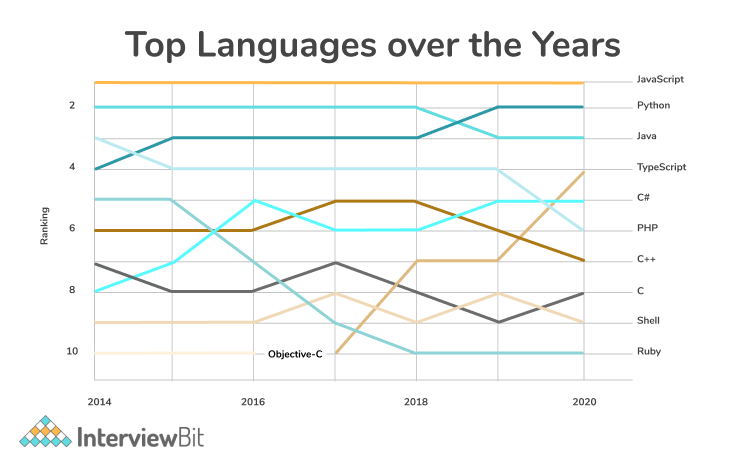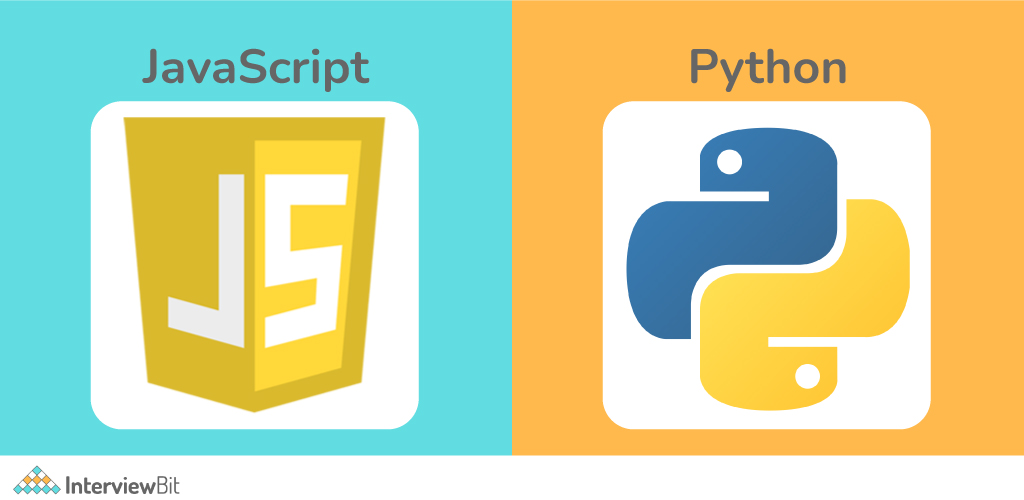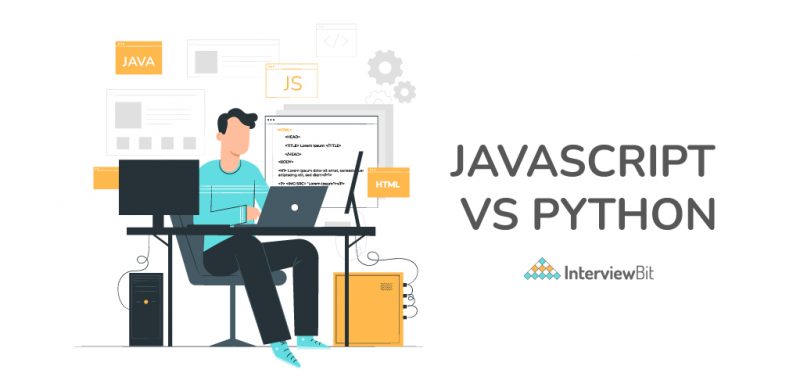- What is JavaScript?
- What is Python?
- Key Differences Between JavaScript and Python
- JavaScript Vs Python: Difference and Comparison
- Conclusion
- FAQs
- Q.1: Is JavaScript or Python easier?
- Q.2: Can Python Replace JavaScript?
- Q.3: How long will it take to learn Python?
- Q.4: Can we use JavaScript in Python?
- Q.5: Can I learn Python and JavaScript at the same time?
- Additional Resources
In modern times, there are many different programming languages that you can use, but Python and JavaScript remain the two most popular ones that you should be familiar with. Whether you aspire to enter the coding world, or if you want to deepen your knowledge of coding languages, learning Python and JavaScript is going to be an invaluable experience for you if you are looking to make a name in the industry. Though both languages are highly spoken and powerful, they differ significantly in many ways. Interested in learning how Python and JavaScript differ? This article is for you. As we proceed through this article, we will look at what JavaScript and Python are, their unique features, and the differences between JavaScript and Python.
What is JavaScript?
JavaScript has quickly risen in popularity to become one of the most used programming languages. The accessibility of SmartPhones, the Internet and Computers has accelerated JavaScript’s adoption to new levels. These days, almost every Internet-enabled device will use JavaScript in some way or the other. In fact, at one point in time, Firefox even released a Firefox OS, which inspired Kai OS and enabled cheaper smartphone accessibility throughout the world. What’s so special about these Operating Systems, you ask? For starters, this was a Browser-based OS, and all apps on these phones are HTML, CSS and JavaScript-based apps.
JavaScript Features
JavaScript is a high-level scripting language primarily introduced for usage on the client side. With JavaScript, you can quickly build web applications, and these applications enjoy a quicker release cycle compared to other frameworks like Android, iOS etc.
Confused about your next job?
The main features of JavaScript are:
- Object-Oriented Programming: It is an Object-Oriented language, but you can switch to functional programming if needed.
- Cross-Platform Support: Runs anywhere – client-side (browsers, mobile phones, smart devices) and server-side (using Node.js etc.). Developers can potentially build Android/iOS applications (React Native, Ionic, etc.). JavaScript’s ability to run on client and server makes it a cross-platform programming language.
- Open Source: Many Open Source initiatives use JavaScript, and therefore, JavaScript enjoys first-class support in the Open Source community. There are many free libraries and tools available for developers to choose from and use.
- Smaller Release Cycles: JavaScript-based applications have a short release cycle as compared to Android/iOS. Users can get quick application updates. A short release cycle is one of the biggest reasons many startups prefer using JavaScript to build a Minimum Viable Product (MVP) to test the waters.
- User-Interaction APIs: The Browser provides APIs for user interaction like click, drag, drop, hover etc., that developers can use with JavaScript. These APIs come in handy for making interactive applications.
- Security: The Browser environment, where JavaScript runs, is highly secure. Browsers can limit access to information.
- Storage: The Browser includes an API for fetching and storing users’ information on their devices that developers can use via JavaScript.
- Updated Versions of JavaScript: ECMAScript 6, also known as ES6 for short and ECMAScript 2015 for long, is the latest version of the ECMAScript standard. ES6 is the first update to JavaScript since ES5 was standardized in 2009. ES6 provides many APIs that make development easy.
Most Browser Engines are now providing support for ES6. - Memory Footprint: JavaScript-based applications leave a smaller memory footprint on user devices. Progressive Web Apps are a modern implementation of HTML apps that provide an almost native-like User Experience at a fraction of the size of a native Android/iOS app.
- Full Stack Support: Fullstack JavaScript is the most used framework of choice since it requires developers to learn only one language. MERN (Mongo Express React Node) and MEAN (Mongo Express Angular Node).
What is Python?
What makes Python so unique is that the scientific community loves it. It has become the de-facto standard for people working in Artificial Intelligence, Machine Learning, Data Science, Academics, Computer Vision, Image Processing and even biology.
Python is terrific for analyzing vast chunks of data because of its broad library of utilities available in Open Source. That’s not all; Python has also made its name in Web Development with frameworks like Django!

The above graph from the GitHub Octoverse highlights the popularity of how Python has quickly risen in ranks to second only to JavaScript.
Python Features
Python is a general-purpose, high-level programming language. It gained popularity due to its simplicity for writing short programs and the vast array of libraries available in the Open Source universe. Some key features of Python are:
- Syntax: Python has an elegant and straightforward coding syntax as compared to Java, C, and C++. This feature makes Python easier to learn as a beginner.
- Object-Oriented Programming: Python is a robust Object-Oriented Programming Language. The Object-Oriented paradigm makes it a powerful tool amongst its competitors like Java.
- Built-in Library: Python comes with a sizable in-built library so that it can support most programming tasks.
- Cross-Platform Support: Python comes with excellent OS support, and can run on: Windows, macOS, Unix, OS/2, etc. However, we cannot run Python on Mobile devices out of the box.
- Open Source: Python has excellent open-source support concerning developer tools and libraries.
- Scalability: Python codebases are easy to maintain and debug.
Since Python is a High-Level Programming language, you don’t have to deal with memory freeing or garbage collection, although some knowledge will help you build scalable applications. - Database Support: Python enjoys excellent support for Databases, for example, MySQL, psycopg2 (PostgreSQL), Cx-oracle (Oracle Database) etc.
Key Differences Between JavaScript and Python
In terms of use cases, Python and JavaScript have very little in common. Novice programmers mostly use Python to work with Data Science, AI, ML or Computer Vision, while Web Applications need JavaScript. So, it is given that Python cannot run on web browsers without some configuration and using some tool like Transcrypt or Brython.
Another significant difference between Python and JavaScript is that Python supports multi-threading; however, JavaScript is single-threaded. JavaScript runs on a single thread in a Browser environment or a Server environment (there are ways to make multiple processes run for Node, but it doesn’t come out of the box). With Python, multi-threading is a part of the package. Multi-threading makes Python great for multitasking.
The most influential factor why Python isn’t as popular as JavaScript is that it doesn’t run on Mobile Phones. This difference makes JavaScript the champion in the real world.
JavaScript Vs Python: Difference and Comparison

Python is a great programming language, and so is JavaScript. But there are many differences between the two, creating different use cases for the two programming languages. Python is used more in academic circles, while web applications cannot function without JavaScript.
On that note, let us dive into the differences between Python and JavaScript.
| JavaScript | Python |
| The JavaScript programming language, which adheres to ECMAScript specifications, is used for various applications, including web development, games, and more. | As a high-level general-purpose interpreted programming language, Python emphasizes the readability of code, and it is considered one of the top programming languages today. |
| The JavaScript programming language uses a prototype-based inheritance scheme. | The Python programming language uses a class-based inheritance scheme/model |
| The Java language doesn’t care whether the parameters that are passed to the function are correct or not. | If the incorrect parameters are passed to a function in Python, an exception is thrown. |
| In JavaScript, only some primitive data types like Number and String are immutable, while others are mutable. | Python has a variety of immutable data types like Tuple, Int, Float, Complex, Bytes |
| The six primitive data types in JavaScript are: undefined, Boolean, String, Number, BigInt, and Symbol. | Python has only four primitive data types: Booleans, Integers, Float, and strings. |
| Only UTF-16 format encoding support is present for JavaScript source code. | A user can specify an encoding format for Python source code; it is ASCII by default. |
| All floating-point numbers in JavaScript are of type Number. There is no distinction between integers and floats. There is another data type called Big Int for huge integers in JavaScript. | In Python, there are many different numeric types like int, fixed-point decimal, etc. |
| There are two types of comments in JavaScript: 1. // Single Line Comment 2. /* Multi * line * comment */ | There’s no multi-line comment in Python; you can just add a # followed by a comment. # This is a comment |
| There are falsy values in JavaScript like null and undefined. However, not all of them denote the same thing. | Python only has None to indicate non-existent values. |
| There are two kinds of equality comparison operators in JavaScript. “==” and “===”. With “==”, you can ignore the type of the two items being compared and only compare the values. | There is only “==” in Python. You cannot ignore the type of the two items being compared. |
| JavaScript uses curly brackets for code blocks. Spaces inside curly brackets are entirely optional but often recommended. | Python uses indentation to identify code blocks. It makes the code more readable, and the spaces are not optional. |
| There is limited support in JavaScript regarding modules like RegExp, Date, Math, JSON etc. | Most common programming tasks are available as modules in Python. |
| There are few built-in Data Structures in JavaScript. You can use Arrays to act like Stacks and Queues. | Python has many inbuilt Data Structures like Lists, Tuples, HashTables or Dictionaries, etc. |
| There are constants in JavaScript, using ES6. We can use them with the const keyword. | There are no constants in Python. You have to stick to the style guide to denote constants. |
| JavaScript is great at non-blocking IO tasks and single-threaded. | Python is excellent at non-blocking IO tasks, too and is multi-threaded. |
| There is prototype-based inheritance in ES5. With ES6, one can define and use classes to have a class-based inheritance; however, it is usually transpiled into ES5. Therefore, JavaScript doesn’t have a native class-based inheritance. | Python has an inbuilt class-based inheritance model. |
| With JavaScript, you can build native mobile apps with frameworks like React Native. | Python is excellent for data-intensive tasks, Math operations, AI and ML. However, we cannot use it to build native apps for mobile devices. |
| Frameworks like Node, and Deno enable building Web Applications using JavaScript. | Frameworks like Django enable building Web Applications using Python. |
Conclusion
So, which language should you learn? The key takeaway here is, it depends on the why.
JavaScript is a great tool and can be used to build excellent web applications.
Python is also an excellent high-level programming language that developers and students can use to analyze extensive data, AI, ML, and build tools for academic research.
It ultimately depends on your use case as to which programming language you should choose. Python is the go-to language for most academic or data purposes, and JavaScript comes in handy for building web and mobile applications.
In summary, Python is suitable for data-intensive work or academic reasons, while JavaScript is great for building apps.
If you’re looking to choose between the two, the following FAQs might help.
FAQs
Q.1: Is JavaScript or Python easier?
Ans: Both of them are simple and easy to learn, so it ultimately depends on your use case. Python will come in handy with its inbuilt data structures and library support for most academic reasons, like a course in Data Structures & Algorithms or a project in AI/ML.
If you want to write a backend application, Python and JavaScript are both equally impressive.
However, you need JavaScript if you are looking at building an application with a Frontend.
Although, in terms of the learning curve, Python is said to be easier.
Q.2: Can Python Replace JavaScript?
Ans: The simple answer is NO.
It is possible to use tools like Transcript and Brython to run Python on the web browser. However, transpiring Python into JavaScript leads to slower Web Applications. Therefore, it’s not a good idea to convert Python into JavaScript.
Q.3: How long will it take to learn Python?
Ans: It usually depends on the person learning the language; however, one can understand the Python syntax in a couple of days if you’re familiar with any other programming language. Here’s a handy cheat sheet to help you out.
For a complete beginner, it may take a week to learn and reach a comfortable level in Python.
Q.4: Can we use JavaScript in Python?
Ans: You can use a JavaScript runtime engine from within Python, like PyV8. You may also refer to this StackOverflow question.
Q.5: Can I learn Python and JavaScript at the same time?
Ans: Of course, you can. Barring some syntax, both these programming languages have very similar logic and structure. More often than not, developers can use concepts from one programming language in the other.




